Olympic lifting is all about harnessing power. From the very first day you pick up a barbell, weightlifting teaches — and demands — that you be strong, fast, nimble, and explosive.
All of those qualities are trained in excess with the clean pull. For weightlifters, pulls are an accessory meant to develop better posture, reinforce technical precision, and bolster strength.
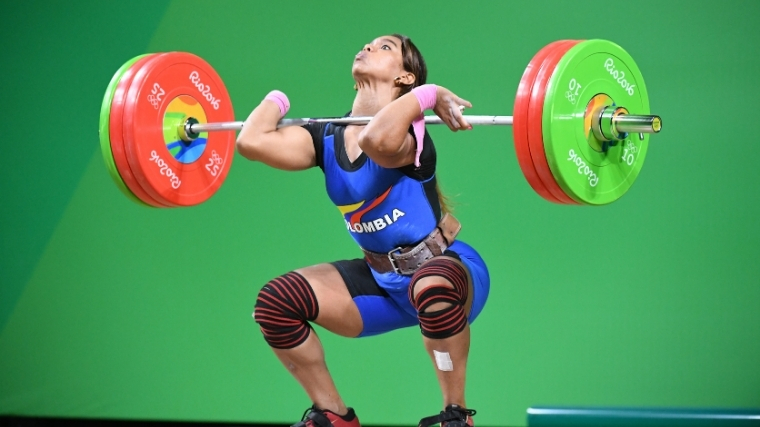
However, you can use the clean pull to make all kinds of other gains, even if the snatch and clean & jerk have no place in your program. Here’s how.
- How to Do the Clean Pull
- Sissy Squat Sets and Reps
- Common Clean Pull Mistakes
- Clean Pull Variations
- Clean Pull Alternatives
- Muscles Worked by the Clean Pull
- Benefits of the Clean Pull
- Who Should Do the Clean Pull
- Frequently Asked Questions
How to Do the Clean Pull
If you’ve ever done a deadlift, you have everything you need to perform the clean pull. It would be wise to work with bumper plates if you have them, since you’d typically let the barbell fall at the end of each rep.
Further, a pair of weightlifting shoes will go a long way toward helping the movement “feel” correct, but they aren’t mandatory. You also might want a pair of straps if you’re pulling particularly heavily, or for high reps.
Step 1 — Set Up
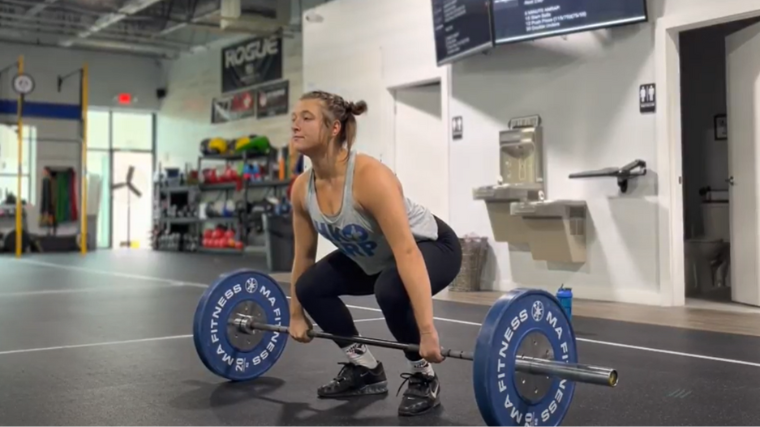
First things first, address the barbell. Stand roughly hip-width apart with the barbell directly over your foot, where your toes attach.
Then, sink down and hit the following beats; knees over the barbell, shoulders directly above (or slightly ahead), lower back flat, and chest up. Your hips should be a little higher than your knees. Fix your gaze forward.
Coach’s Tip: Find a stationary object around eye level and keep your eyes trained on it the whole time.
Step 2 — Push Hard
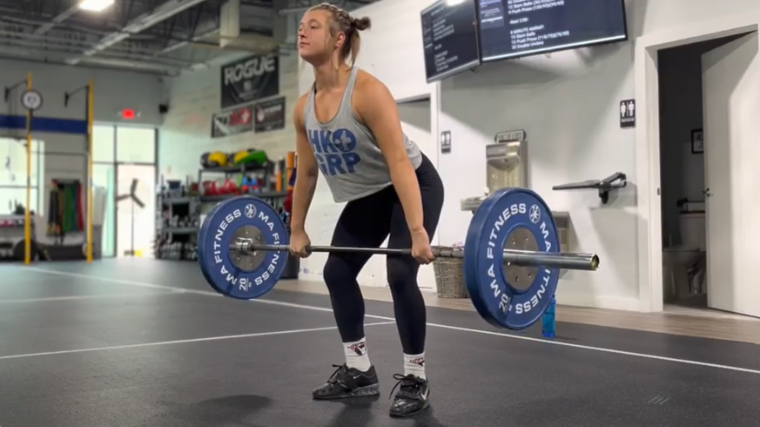
Once you’ve set up, initiate the movement by pushing straight down into the floor with your legs. Your knees should naturally drift out of the path of the barbell. Keep your shoulders stacked over the bar vertically as you push with your whole foot firmly on the floor.
Coach’s Tip: Your torso angle should remain the same during this step; ensure your shoulders and hips are rising at the same rate.
Step 3 — Get Tall
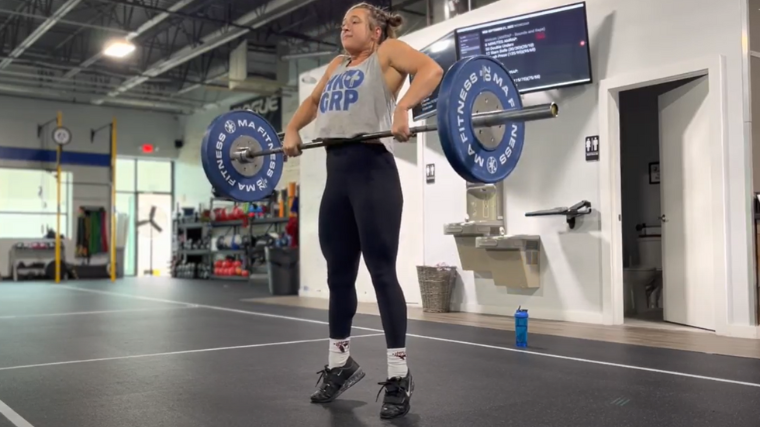
Once the barbell has passed your knees, continue to push downward. As you approach your upper thigh, think about forcefully snapping your legs and hips into extension and making yourself as “tall” as possible.
As the barbell flies upward, shrug hard at the top and allow your elbows to bend slightly. Allow the barbell to reach its apex and then let it fall back to the floor while maintaining a loose grip.
Coach’s Tip: The moment of contact and extension should be forceful, but not impactful. Think of how you’d skip a rock across the water, and try to mimic that.
Clean Pull Sets and Reps
The clean pull may not be the most versatile exercise out there with respect to programming options, but you can still utilize it for different purposes or goals.
- To Learn the Technique: 4 to 6 sets of 3 reps with a light to moderate load.
- For Power Development: 5 to 8 sets of 1 or 2 reps with a moderately heavy (but not max effort) load.
- For Max Strength: 3 to 5 sets of up to 4 reps with a heavy load.
Common Clean Pull Mistakes
It may not be as technically intricate as a competition-worthy snatch, but the clean pull is no run-of-the-mill barbell exercise either. Be mindful of these typical technical pitfalls so you can sidestep them cleanly.
Treating It Like a Deadlift
Don’t get it twisted — the clean pull is not a deadlift variation. Your goal isn’t to stand up with the weight in the most efficient manner possible or to emphasize hip extension to an extreme degree.
In the clean pull (and the clean itself), think of your legs as the engine that creates your power, and your back as the frame that supports your movement.
You need both working synergistically, so don’t try to apply your deadlift prowess to the clean pull.
Coming Up Onto Toes Early
While making yourself “tall” and generating upward momentum on the barbell is crucial, you should avoid any anxious movement.
Don’t try to “skip” through the phases of the clean pull and rush into your extension by coming up onto your toes before the barbell is around your upper thigh.
Doing so may throw you off balance and can limit your force output. It’s easier to push into the floor if your entire foot is in contact with it. Your heels should lift organically; don’t think of it as a calf raise.
Using Your Arms
Make no mistake, a vast majority of all power and motion generated in the clean pull comes from your quadriceps and glutes. However, your upper body does come into play to guide the barbell upward in a straight line.
This does not mean you should be pulling on the bar with your arms before you’ve fully utilized your legs: The clean pull is not an upright row and you shouldn’t think of it as such.
Once you’ve reached triple extension (with your ankles, knees, and hips straightened), shrug hard to get another inch or so of bar height.
Clean Pull Variations
The clean pull requires a specific posture and grip on the barbell, but the essence of the movement can be found elsewhere via variations. Try these out if the clean pull isn’t doing it for you.
Snatch Pull
The motivation, execution, and intent of the snatch pull are mostly identical to that of the clean pull. However, you’ll simply be adjusting your grip significantly outward.
All the technical elements other than your grip remain the same. You won’t be able to use quite as much weight in the snatch pull, and it will also challenge your grip strength and hip mobility a bit more, since you have to sink into a deeper posture during the setup.
Clean High Pull
A high pull is distinct from a standard weightlifting pull in only one (obvious) way; the height to which you pull the bar.
High pulls emphasize upward trajectory, or bar path, more than standard pulls and allow you to “feel” your upper body working. They’re also easier to recover from, since you aren’t lifting quite as heavily.
Block Clean Pull
If you want to develop explosive lower body power but don’t want to necessarily re-learn pulling from the floor, you can turn to the block clean pull instead.
By starting the movement with your barbell resting on blocks (usually around knee height), you can zone in on the second half of the movement and not have to worry about setting up from the floor.
Clean Pull Alternatives
It’s perfectly okay if the clean pull doesn’t tickle your fancy. There’s more than one way to train muscular power that doesn’t entail borrowing from the technically-demanding sport of weightlifting.
Trap Bar Jump
You can work with the trap bar to train a very similar motion to that of the clean pull. The caveat is that you may not be able to lift comparably heavy weights.
On the upside, jumping with the trap bar is far easier to learn and may feel more natural to beginners or those without sport-specific backgrounds.
Power Clean
If you do particularly enjoy the technique and postural elements of the clean pull, you can take it one step further and learn the power clean instead.
The power clean is, essentially, a clean pull that you catch in the front rack. It’s more difficult and has a steeper learning curve, but you might find it more rewarding to feel your bar fly in space and catch it dynamically.
Power Shrug
You can tune down the technical difficulty of the clean pull by opting for power shrugs instead. Power shrugs are, essentially, rack (or block) pulls with a whole lot of trapezius engagement at the top.
With a little bit of intentional body English, you can explosively shrug very heavy weights quickly to develop power — and beef up your yoke at the same time.
Muscles Worked by the Clean Pull
The clean pull will hit just about every muscle in your body to some degree, making it a fantastic full-body exercise option. However, a few key muscle groups stand out from the rest in this exercise.
Quads
Your quads are the engine at the heart of the clean pull. Since the posture and setup for weightlifting pulls are different from your standard deadlift, you’ll typically end up using a lot more leg drive than you might be used to.
Your quads begin the lift by breaking the barbell off the floor and help to push your torso upright until you extend.
Lower Back & Glutes
If your quads are the engine behind the clean pull, your posterior chain is the framework that makes it all possible.
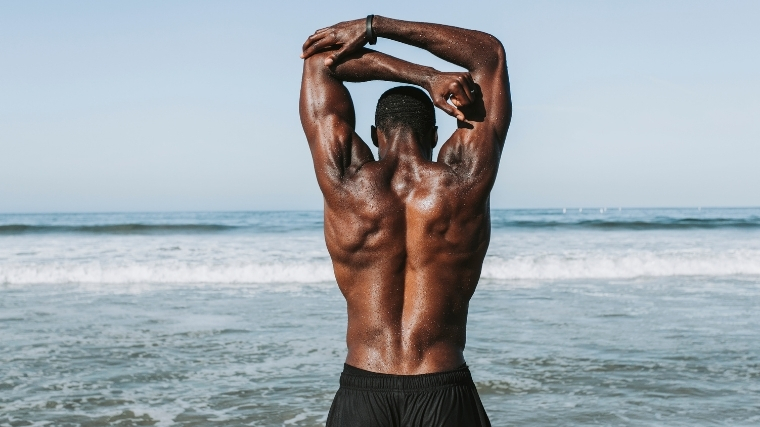
[Read More: Best Lower Back Exercises for Strength and Reduced Pain]
You need a strong and stable lower back to tolerate the heavy weights used in the pull, as well as active glutes to facilitate hip extension at the top for maximum bar height.
Upper Back
Most of the work performed by your upper back in the clean pull is isometric. However, at the very end of the range of motion, you can rapidly shrug your shoulders to bring the barbell upward in a straight line.
This shrugging motion, facilitated mainly by your upper and middle trapezius, can be quite stimulating to your upper back if you’re not used to training at such high velocities.
Benefits of the Clean Pull
The clean pull isn’t appropriate for everyone. However, if you’re certain about what goals you’re trying to reach, it can be an extremely potent tool.
Reinforces Clean Posture
Olympic lifters utilize pulls as a way of drilling and reinforcing proper posture in the snatch and clean, without having to perform those movements specifically.
And, since you typically can use heavier weights during pulls than you can actually clean or snatch, weightlifters also get some free strength work and progressive overload along the way.
Develops Posterior Chain
No matter how you slice it, the clean pull is a fantastic way to stress and develop your posterior chain, from your calves to your traps.
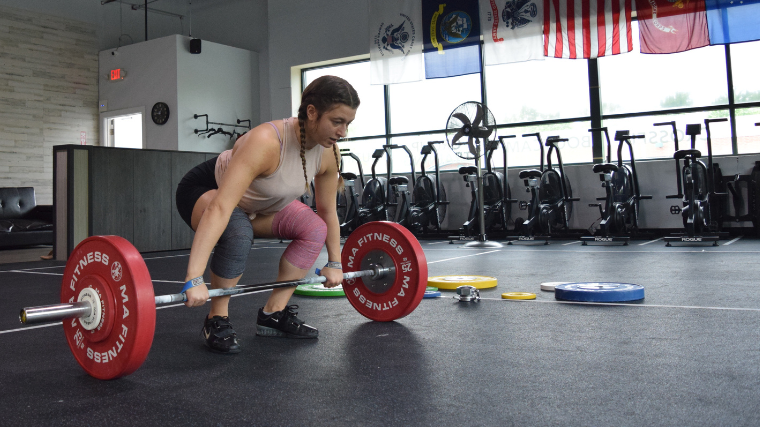
The backside of your body has to work both isometrically and dynamically — depending on the stage of the exercise — to move and control the barbell as it flies through space.
Teaches Power Development
More than anything, the clean pull teaches you how to coordinate your body and generate force. This kind of skill is relevant not only for certain strength athletes, but is a necessity for general athletics as well.
Who Should Do the Clean Pull
If you’ve already been sold on the merits of the clean pull, you have more than enough reason to start learning the technique right away. After all, fun is a perfectly valid motivator when you’re in the gym.
However, consider if you fall into one of these camps, as you might be particularly well suited to learning the exercise.
Beginner Weightlifters
Aspiring Olympic lifters should make the clean pull (as well as the snatch pull, frankly) a large part of their practice in the gym.
Pulling is only one half of the competition clean, but what you do from the moment the bar breaks the floor can make or break the lift itself.
Working pulls into your sessions allows you to learn the correct technique without having to worry about actually catching the flying barbell.
Advanced Weightlifters
Experienced weightlifters utilize the clean pull as well, but not necessarily for the same purposes as a beginner would.
If you’re already pretty tenured with the barbell, you can use the clean pull as part of your accessory training to develop general lower body strength or as a max-effort primer close to competition.
Traditional Athletes
Most types of traditional athletics — think basketball, football, track, and more — require their athletes to be in the weight room at least a few times a week.
Exercises like the clean pull are commonplace in many sports, as they’re a great way to develop hypertrophy and teach bodily coordination.
However, you may not have enough hours in your training week to learn the rigors of the snatch or clean. If that’s the case, clean pulls take half as much time to learn and provide all the athletic benefits, making them extremely efficient tools.
Clean Up Your Pull
If you want to be the best athlete, whether on the weightlifting platform or out on the field, you need both strength and skill. Strength helps you go the distance in (and out of) the gym, but you have to be able to express it proficiently.
The clean pull kills two birds with one stone. Not only will it beef up your legs and back and teach you to utilize the explosive power of your lower body, it doubles down on the correct posture and timing for the clean itself.
Put it into your program and the gains will speak for themselves.
FAQs
Still have lingering questions about the clean pull? No worries, we’ve got answers.
Is the clean pull the same thing as a deadlift?
No. A deadlift is completed when you stand fully upright with the barbell, but a clean pull requires you to extend your lower body and drive the bar up to around the height of your belly button.
Are clean pulls safe for beginners?
Absolutely. No exercise is inherently dangerous; it’s all about how you use it. You can start doing clean pulls with very light weight to familiarize yourself with the technique.
Featured Image: Riley Stefan